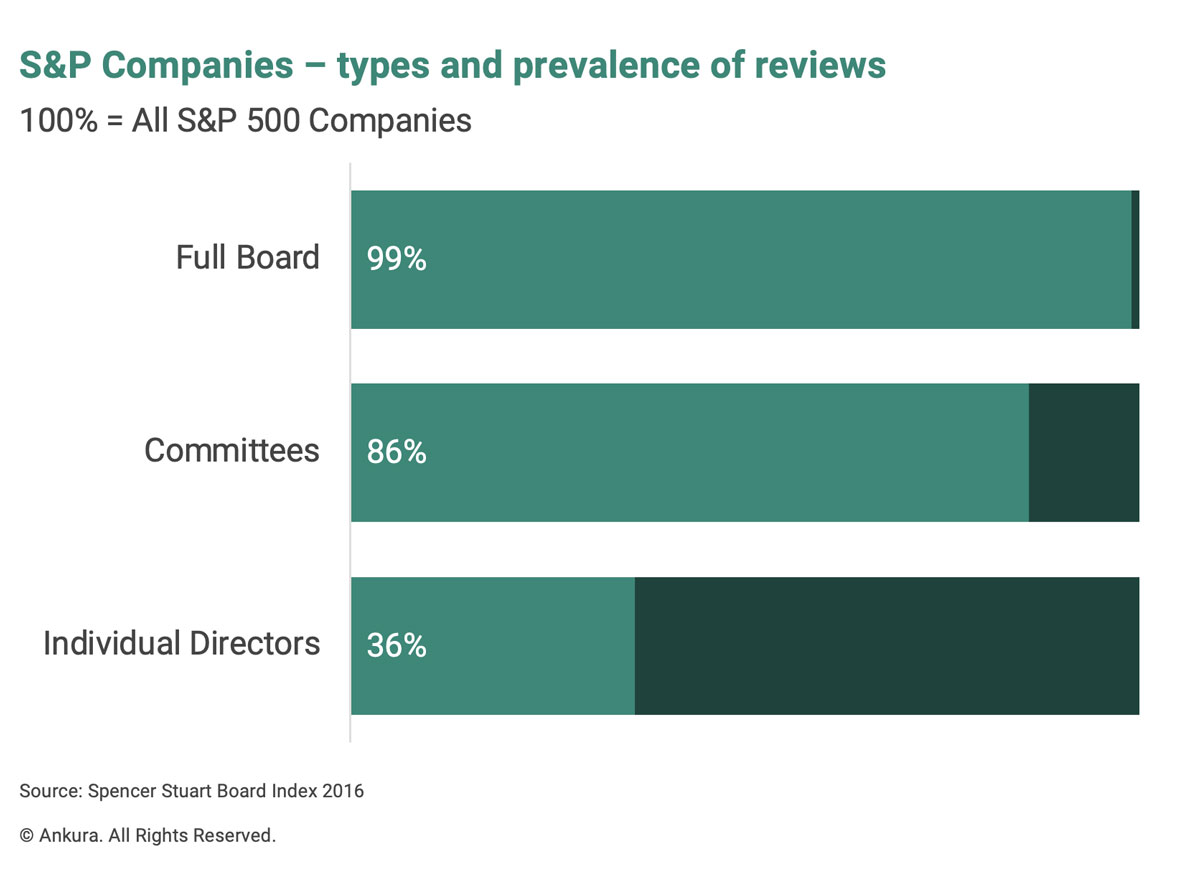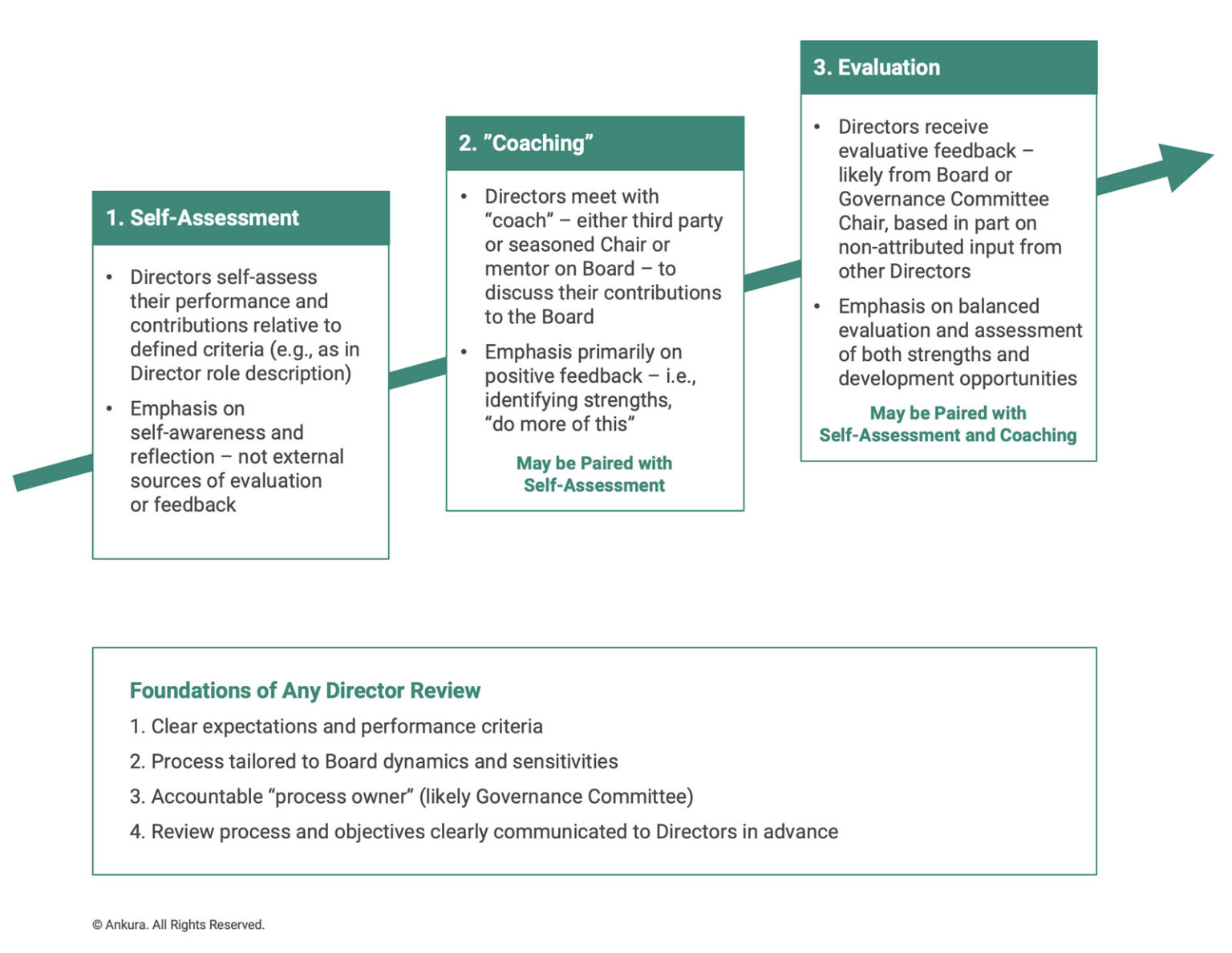November 2020 — CORPORATE GOVERNANCE has been in the spotlight. Boards have been busy addressing issues related to executive compensation, cyber threats, enterprise risk management, and in general, seeking to keep the raiders and activists at bay through diligent work. As they do this important work, virtually all corporate Boards conduct some type of annual assessment of the Board as a whole.
You would think that individual Directors – the stuff of which good Boards are made – would be subject to a similar, institutionalized process of recurring assessment and feedback, right?
You would be wrong.
Only about one-third of public company Boards report a recurring, formal process for individual Director assessments and feedback (Exhibit 1). Moreover, few Directors believe their Boards are effective at providing feedback to individual Directors.[1]PMG, Enhancing Evaluations for Boards, Committees, and Directors, 2017. Annual Director elections – used by 92% of S&P 500 Boards[2]Spencer Stuart Board Index 2016. – are one “market signal” – but these elections are not a substitute for recurring feedback on individual Directors.
The Case for Director Evaluations
Despite limited adoption, the case for instituting individual Director evaluations is strong:
- First: It’s a best practice, as endorsed by governance bodies in the US, UK, Australia, and other countries.
- Second: Directors sit on Boards for a long time, and a formal evaluation and feedback process offers the opportunity to enhance capabilities – and perhaps refine behaviors – as the company’s needs change. Consider that the average Director tenure is 7 years, with 37% of independent Directors sitting on public company Boards for 11 or more years.3 That’s a long time to go without systematic feedback.
- Third: Up to 77% of Directors believe they are not receiving effective feedback today4 – and our interviews indicate that many would appreciate some feedback that provides helpful guidance on their important role – though there are some important sensitivities that need to be taken into account.
- Fourth: Board dynamics can become inefficient due to differing styles and behaviors without a formal, recurring process for Director feed-back. Many Chairs have mentioned to us that one or two disruptive Board Directors significantly erode the effectiveness of the Board, taking discussions off-track or engaging in an unproductive way. As one seasoned Board member said, “There’s a lot of frustration on our Board with certain individuals for over-engaging – but currently we don’t have a means to convey that feedback in a constructive way.”
- And finally: an institutionalized evaluation process can be a mechanism to address cases of Director under-performance. Specifically, having an established process in place relieves the Chair or Governance Committee from having to trigger an ad hoc intervention, which might otherwise be deferred until it’s long overdue. In extreme cases, an institutionalized Director evaluation can facilitate a Director step-ping down or support a decision to not to re-nominate a Director.
Barriers Loom
Given these benefits, why do so few Boards invest in formal processes to evaluate Directors and deliver feedback?
Simply put, very few people enjoy getting, or giving, feedback. Board Directors are no different, and there are a few additional sensitivities that present barriers.
One issue is a fear of eroding trust within a well-functioning Board. As the general counsel of a Fortune 500 company said to us, “Our Board Chair has a reasonably smoothly-running Board right now, and good relationships with Directors. He doesn’t want to introduce a process that could cause waves and disrupt what’s working well.” This can be sensitive for Boards with long-tenured Directors who have developed close relationships with one another.
A second issue is actionability. Since most Directors of listed companies can only be removed from the Board by shareholder vote, why bother? As we have seen in many Boards, feedback to Directors can moderate behaviors in the boardroom, encourage better preparation, and help keep discussions on track – though coaching can’t turn a rooster into a songbird.
A third area of concern – that has been overcome by the 36% of Boards that do conduct regular Director evaluations – is the risk that identifying gaps in Director performance could create legal exposures. While this is worth considering, particularly for companies in highly regulated or litigious arenas, we believe that a carefully constructed and administered diagnostic with appropriate legal guidance can sidestep this issue.
A final issue: often there isn’t a good starting point for Director evaluations. True, the Boards of most large and/or public companies do put in place descriptions of Director roles, fiduciary and legal duties, requirements for meeting attendance, and codes of conduct. But these policies rarely convey a robust or nuanced description of “what good looks like” at the level of individual Director conduct. In other words, the essence of good directorship – e.g., advancing Board discussions by bringing insights, engaging at an appropriate level of detail, etc. – is not described in the usual role description. Without a written and well-socialized document laying out explicit expectations for Director contributions and conduct, Director evaluations are at best unproductive and at worst unfair.
Starting the Journey
We believe that most Boards should institute some type of Director evaluation and feedback. This should go beyond a purely informal, ad hoc discussion led by the Board or Governance Committee Chair. That said, Director evaluations need to be designed and administered carefully, with a number of design questions and potential models to consider.
Following are some perspectives, based on our experience supporting numerous Boards:
1) Set clear performance criteria as the starting point for individual Director evaluation. As one Director said to us, “I have no idea what the performance criteria are for me as a Board Director.” Addressing this sort of ambiguity will probably require work to refine and implement a Director role description –likely carried out by the Governance Committee with the input and approval of the Board. Revised Director role descriptions should be in place for at least 12 months before any evaluation relative to these criteria is instituted.
2) Consider a range of options for Director evaluation. There are many choices available (Exhibit 2). Key dimensions include: who collects feedback and how; who sees the feedback; how that feedback is delivered; etc. We also observe that pure self-assessments – though they may be a good starting point for Boards in the early stages of building a Director evaluation approach – rarely drive significant changes in behavior. As one Director put it, “Every Director, even the worst offenders, will rate him or herself a 4 or 5 out of 5. The only exception to this is the humblest Director, who is also probably the strongest contributor of the lot.”
3) Build alignment around an approach – taking into account the unique dynamics and sensitivities of your Board. This is intuitive but should not be understated. Imposing an evaluation process without sufficient buy-in across the Board risks hostility and defensiveness and could undermine the success of the evaluation exercise as a whole. A better way is to charge a sub-group of the Board – often the Governance Committee – with spearheading the initiative, framing a set of options and design choices, and soliciting input from other Directors to develop an approach that reflects the specific needs and dynamics of the Board.
4) The right approach is usually a phased one. Most Boards approach Director evaluations in a phased way, so as to build Directors’ comfort and trust in the process. One Board conducted pure self-assessments for four years before tasking its Governance Committee with collecting and delivering more explicit feedback to Directors. Over that four-year period, Directors came to recognize the limited capacity of self-assessments to influence problematic behavior, and collectively agreed to an evaluation approach with more “teeth.”
There’s considerable irony that corporate Directors, often among the greatest proponents of performance management and accountability during their professional careers, themselves operate in a feedback-free world. We believe it’s time to change that. Doing so will take some creativity and situation-awareness – and creating a process that reflects the unique dynamics of a corporate Board.





Comments